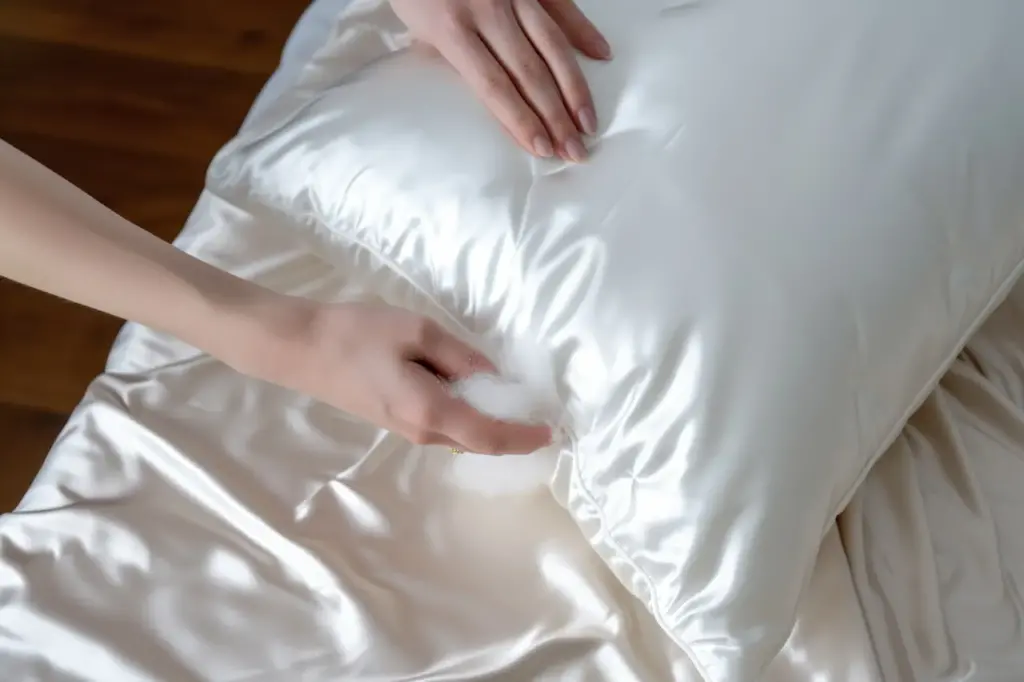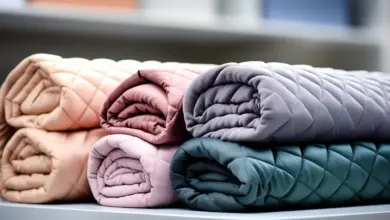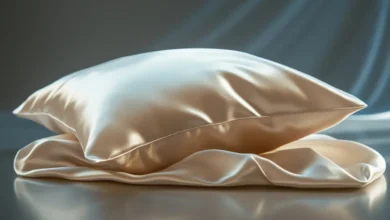The number of choices available on the market when looking for a new cushion can be overwhelming. You may find it difficult to select a pillow for your needs, given the wide variety of materials available. We’ll examine two of the most common materials used for pillows, feather and down to determine which is best for you.
We’ll first discuss the differences between feather and down pillows, and then we’ll describe which materials might be best suited to different sleepers.
Definitions of feather vs. down pillows

What is a down pillow?
Down pillows are luxury pillows filled with soft, fluffy clusters that come from the undercoats of ducks or geese. They do not have stiff quills. The clusters of down are called plumules and trap air to keep birds warm. Hungarian goose is considered to be the highest quality and most expensive down material.
The advantages of down pillows
- They are fluffier, lighter, more malleable and durable.
- Squishys can be moulded to any shape and will quickly return to their original fluffy state.
- Some people may prefer this, while others may not.
- A higher fill power is a sign of a higher loft and a better down pillow.

Cons of Down Pillows
- The pillow is more expensive, but it lasts much longer than memory foam, feather pillows, or polyester pillows.
- Due to their natural insulation, pillows are a little warmer. A down pillow may not be the best choice if you sleep hot.
- Support from down pillows depends on the loft, fill power, and the ratio of down/feathers. In general, however, they are not as supportive as latex or memory foam pillows.
You can also find down-alternative pillows that mimic the natural feel of down but are made from synthetic or natural materials such as polyester, bamboo or cotton. They are more affordable and sleep cooler. They’re also a great option for people who have allergies to down feathers. They don’t last nearly as long as down pillows.
Duck Down: Duck Down:
You may find that goose or duck down is more expensive when shopping for down pillows. Duck down has a lower fill power and is less warm than goose down. There is no significant difference between goose and duck down unless the fill power of your pillow exceeds 800. Some people may also say that duck down smells, but this is only true if the down has not been properly cleaned.
What is a feather pillow?
The feather pillows are made from soft and supple plumage and the quills of the duck or goose’s wings and back. The feathers are less plush but more supportive because they have stiff quills in the middle. The main disadvantage of feather pillows is the fact that the quills can poke through the pillowcase at times and cause discomfort. Over time, the feathers in the pillow can also begin to fall out. The pillow may become lumpy.
To achieve the desired loft and fluffiness, most feather pillows are blended with different amounts of down. A pillow with more feathers will provide better support while a pillow with more down filling will make it loftier. Higher content usually means higher prices.
Feather pillows have many advantages:
- Soft, but not as soft and fluffy as down.
- Feathers offer better and heavier support than down.
- Not as durable as down, but more affordable than down.
- It doesn’t trap as much heat as down.
Cons of Feather Pillows
- The quills can cause discomfort.
- These pillows aren’t as fluffy as down, but they are more fluffier than polyester and memory foam.
- The feathers are flat and easily collapse, so they need to be fluffed regularly.
The Differences and Similarities Between Feather and Down Pillows
Let’s compare down and feather pillows now that we have a basic understanding of them.
Similarities with
- Both materials are made from natural sources (feathers and down are taken from the wings and back of the bird, while feathers are taken from its undercoat).
- Both are pretty durable. However, the down version has a slightly longer lifespan (between 3 and 4 years).
- Memory foam pillows are comparable in price to standard pillows, but both are more expensive.
Differences between
-
- Feather pillows tend to have a crisper and more pronounced texture, whereas down pillows are more lofty and fluffy.
- Feather pillows offer more neck and head support and are firmer than down pillows.
- Once compressed, a down pillow will spring back into shape very quickly. Feather pillows can take longer to recover their original shape.
- Due to the air pockets that exist between the feathers, feather pillows are cooler. If someone is hot at night, a down or feather alternative pillow will be better.
- Feather pillows are more likely to break down than down pillows.
- Down pillows are 30% to 50% more costly than the feather pillows. A good quality down cushion can cost between $100 and $150. Feather pillows usually fall under $70.
- Feather pillows can be washed, but down pillows cannot.

Which Pillow Should You Choose?
We’ve listed the key factors that will help you make a more informed decision:
- Cost Feather pillow is more affordable than down. A feather pillow will work for you if you are on a tight budget.
- Comfort and Feel: Down pillows are plusher and voluminous, and they have a softer feel. Feather pillows are flatter and provide more support. Feather pillows can be slightly cooler than down pillows, but this also depends on what type of outer pillowcase is used.
- Sleep Position: The sleeping position is the most important thing to consider.
- You should use a thin or no pillow if you prefer to sleep on your stomach. For stomach sleepers, a low-profile down pillow with a low to medium fill will be best.
- Back Sleepers require a medium-sized pillow to maintain their spine’s natural shape. Back sleepers should choose a medium-profile down pillow, or a 60/40 feather/down mix.
- Side Sleepers Need a Pillow with a High Loft and Medium Fill to Align the Head, Neck, and Spine Naturally. For side sleepers, a high-profile down pillow or a mix of 80:20 feathers and down is recommended.
- A down or feather medium loft pillow would be the best option for combination sleepers as it provides adequate support in any position.
- DurabilityFeather pillows are less durable than down pillows, but more resilient than polyester pillows. A down pillow of good quality can last for 3 to 4 years, while feather pillows are only good for 18 months to three years.
- Care Both down and feather pillows must be fluffed regularly and aired to maintain their shape. feather pillow should not be washed unless it is an emergency. Down pillows, however, can be machine or hand-washed. Before using the down pillows, they must be completely dried.
The Bottom Line
Feather and down pillows are sometimes sold as interchangeable. However, subtle differences in support and comfort can make all the difference. Down pillows offer unparalleled luxury and coziness, but not everyone will appreciate them. Feather pillows offer a compromise between comfort, support and affordability.
This guide should have helped you to understand the differences between feather and down pillows. You can then decide which pillow is best for you. Please leave us a comment if you have any further questions. We’ll be glad to assist.




